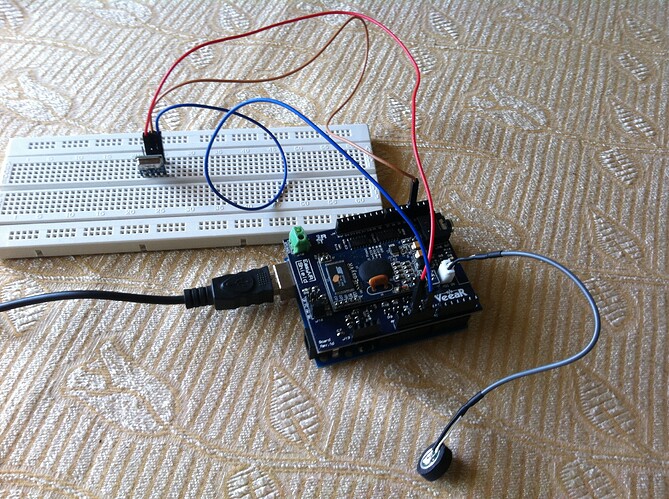Hi,
I am trying to recognize words using the VR Shield, and send a character through the RF module. I am using the virtual wire 1.9 library for the RF module.
The VR Shield stops working when I setup the RF module using the command: vw_setup(2000);
Is it because VR Bot is using up all the pins on my Arduino?
Can any one suggest me a solution?
#include <VirtualWire.h> // you must download and install the VirtualWire.h to your hardware/libraries folder
#undef int
#undef abs
#undef double
#undef float
#undef round
#if defined(ARDUINO) && ARDUINO >= 100
#include "Arduino.h"
#include "SoftwareSerial.h"
SoftwareSerial port(12,13);
#else // Arduino 0022 - use modified NewSoftSerial
#include "WProgram.h"
#include "NewSoftSerial.h"
NewSoftSerial port(12,13);
#endif
#include "EasyVR.h"
EasyVR easyvr(port);
//Groups and Commands
enum Groups
{
GROUP_1 = 1,
};
enum Group1
{
G1_ON = 0,
G1_OFF = 1,
G1_NIKHIL = 2,
};
EasyVRBridge bridge;
int8_t group, idx;
void setup()
{
// bridge mode?
pinMode(11, OUTPUT);
if (bridge.check())
{
cli();
bridge.loop(0, 1, 12, 13);
}
// run normally
Serial.begin(9600);
port.begin(9600);
if (!easyvr.detect())
{
Serial.println("EasyVR not detected!");
for (;;);
}
easyvr.setPinOutput(EasyVR::IO1, LOW);
Serial.println("EasyVR detected!");
easyvr.setTimeout(5);
easyvr.setLanguage(0);
group = EasyVR::TRIGGER; //<-- start group (customize)
// Initialise the IO and ISR
vw_set_ptt_inverted(true); // Required for RF Link module
//vw_setup(2000); // Bits per sec
vw_set_tx_pin(3); // pin 3 is used as the transmit data out into the TX Link module, change this to suit your needs.
}
void action();
void loop()
{
//const char *msg1 = "A";//message to be sent
//const char *msg2 = "B";
easyvr.setPinOutput(EasyVR::IO1, HIGH); // LED on (listening)
group = 1;
Serial.print("Say a command in Group ");
Serial.println(group);
easyvr.recognizeCommand(group);
do
{
// can do some processing while waiting for a spoken command
}
while (!easyvr.hasFinished());
easyvr.setPinOutput(EasyVR::IO1, LOW); // LED off
idx = easyvr.getWord();
if (idx >= 0)
{
// built-in trigger (ROBOT)
// group = GROUP_X; <-- jump to another group X
return;
}
idx = easyvr.getCommand();
if (idx >= 0)
{
// print debug message
uint8_t train = 0;
char name[32];
Serial.print("Command: ");
Serial.print(idx);
if(idx == 0)
digitalWrite(11,HIGH);
else if(idx == 1) digitalWrite(11,LOW);
if (easyvr.dumpCommand(group, idx, name, train))
{
Serial.print(" = ");
Serial.println(name);
}
else
Serial.println();
easyvr.playSound(0, EasyVR::VOL_FULL);
// perform some action
action();
}
else // errors or timeout
{
if (easyvr.isTimeout())
Serial.println("Timed out, try again...");
int16_t err = easyvr.getError();
if (err >= 0)
{
Serial.print("Error ");
Serial.println(err, HEX);
}
}
}
void action()
{
switch (group)
{
case GROUP_1:
switch (idx)
{
case G1_ON:
// write your action code here
// group = GROUP_X; <-- or jump to another group X for composite commands
//const char *msg1 = "A";//message to be sent
digitalWrite(11,HIGH);
break;
case G1_OFF:
// write your action code here
// group = GROUP_X; <-- or jump to another group X for composite commands
digitalWrite(11,LOW);
break;
case G1_NIKHIL:
// write your action code here
// group = GROUP_X; <-- or jump to another group X for composite commands
break;
}
break;
}
}
test2.ino (2.93 KB)
